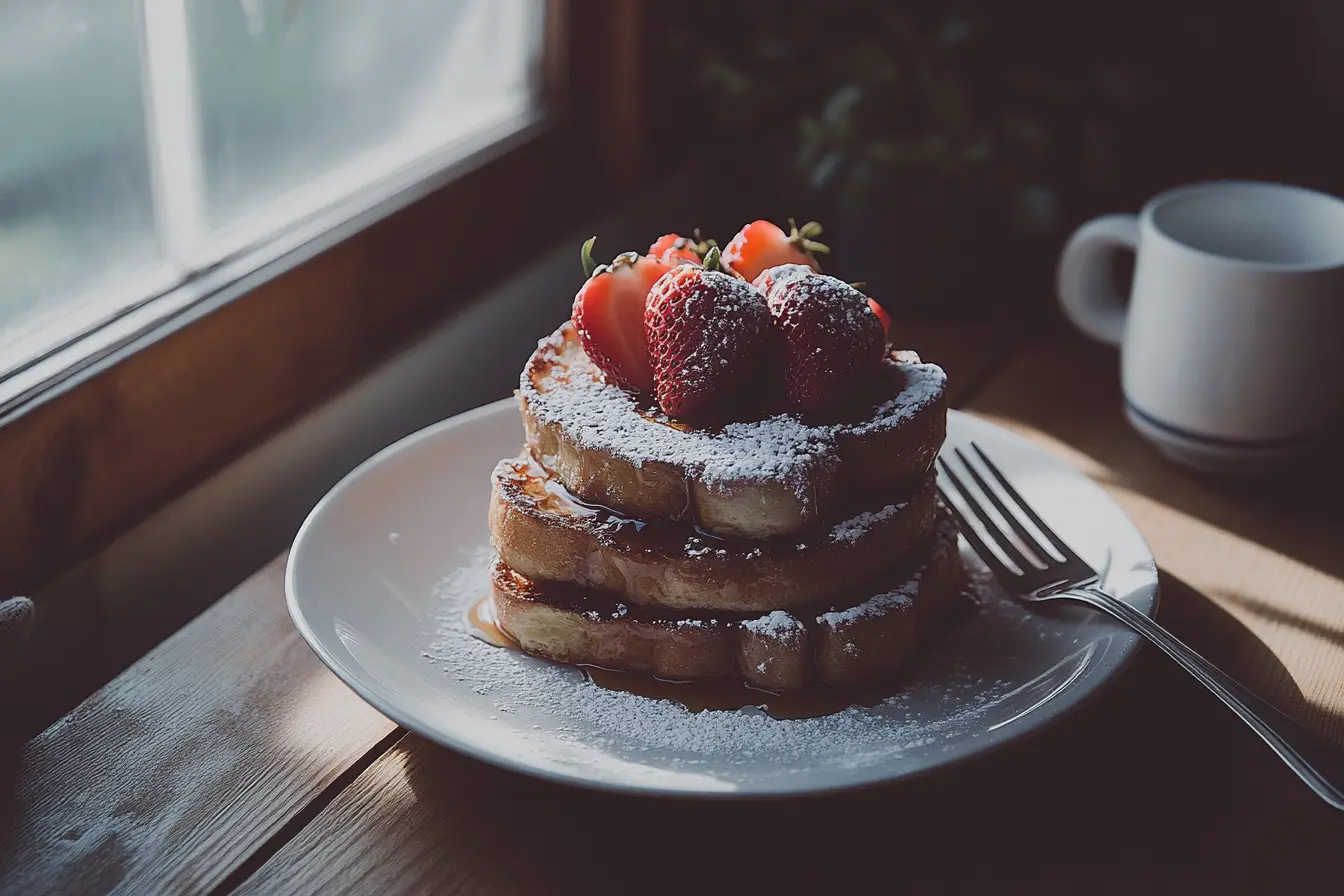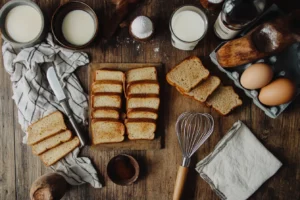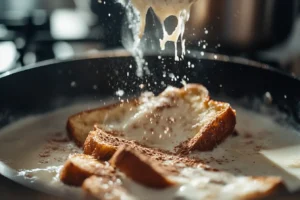French toast is a breakfast favorite for many, but what happens when you’re out of milk or need a dairy-free option? Don’t worry! This French toast recipe without milk is simple, tasty, and just as satisfying as the original. Whether you’re lactose intolerant, avoiding dairy, or experimenting with new flavors, this recipe will be your go-to.
In this guide, we’ll walk you through everything: picking the best ingredients, step-by-step instructions, topping ideas, and even nutrition facts. So, let’s dive in and make this comforting breakfast classic—no milk required!
Introduction to French Toast Without Milk
What Is Dairy-Free French Toast?
Dairy-free French toast is just like the traditional version but skips the milk. Instead, you use milk substitutes or simple water to mix your batter. The result? A golden, fluffy slice of toast that’s every bit as delicious. It’s proof that you don’t need milk to make something incredible.
Why Go for a Milk-Free Recipe?
There are so many reasons! Maybe you’re avoiding dairy for health reasons or you ran out of milk. Milk substitutes like almond, oat, or soy milk offer their own unique flavors, making this dish extra special. Plus, going milk-free is often easier on the stomach while still keeping that same soft, delicious texture.
Benefits of Skipping Milk in French Toast
Switching to a milk-free recipe doesn’t just help with dietary needs; it also opens the door to healthier and more creative options. Dairy-free breakfasts are lighter, easier to digest, and still full of flavor. On top of that, they’re perfect for people with lactose intolerance or allergies.
Ready to learn how to make the best French toast without milk? Keep reading for all the tips, tricks, and techniques to make your mornings brighter.
Essential Ingredients for Milk-Free French Toast
Bread Selection: Choosing the Best Bread
Choosing the right bread is crucial for the perfect French toast recipe without milk. Opt for bread that’s slightly stale, as it absorbs the batter more effectively. Brioche, sourdough, or even whole-grain bread works beautifully. If you prefer gluten-free options, a sturdy gluten-free loaf will do the trick. The thicker the slice, the better—it helps achieve that soft interior while staying crisp on the outside.
Egg Mixture: Creating the Perfect Batter
The batter is the heart of any French toast recipe, and skipping milk doesn’t change that. Instead of regular milk, you can use almond milk, soy milk, or oat milk to create a rich, flavorful mixture. If you don’t have any milk substitutes, water mixed with a dash of vanilla and cinnamon can also work wonders. Remember, the eggs provide structure, so don’t skip them unless you’re trying for a vegan alternative.
Sweeteners and Spices: Enhancing Flavor
Spices and sweeteners bring your milk-free French toast to life! Cinnamon and nutmeg add warmth, while a hint of vanilla makes it irresistibly fragrant. For sweetness, you can mix in a touch of maple syrup, honey, or sugar. These small additions make the batter delicious even before it hits the pan.
Key Tips for Ingredient Preparation
Before getting started, make sure all your ingredients are prepared and ready to use. Crack the eggs into a bowl, whisk them with your chosen milk substitute, and sprinkle in your spices. Don’t forget to cut the bread slices to an even thickness, which helps them cook evenly.
Transitioning to milk-free French toast is so simple when you have the right ingredients.
For more creative recipes, explore our guide on using bananas instead of butter in baking.
Step-by-Step Preparation Guide
Preparing the Batter: Mixing Ingredients
Making the batter for your French toast recipe without milk is quick and easy! First, whisk together the eggs and your chosen milk alternative, like almond or oat milk. Next, add a pinch of cinnamon, a dash of nutmeg, and a splash of vanilla extract. These small additions elevate the flavor and give your toast a warm, inviting aroma. Stir the mixture well to ensure the spices are evenly blended.
Dipping Techniques: Ensuring Even Coating
Once your batter is ready, it’s time to dip the bread. Start by placing a slice of bread into the bowl. Quickly flip it over, ensuring both sides soak up just enough batter. However, don’t leave the bread in too long—over-soaking can make it soggy! If the bread feels too wet, let it rest on a rack for a moment before cooking.
Cooking Methods: Achieving the Ideal Texture
Heat a non-stick skillet or griddle over medium heat, and lightly grease it with butter or a dairy-free alternative like coconut oil. Place the coated bread onto the hot surface, allowing it to cook for about 2-3 minutes on each side. Watch closely as the edges turn golden and crispy. For thicker slices, reduce the heat slightly and cook a bit longer to ensure the center is cooked through.
Tips for Consistency and Flavor
To keep things consistent, stir the batter between dips to prevent the spices from settling at the bottom. Additionally, avoid overcrowding the pan, as this can lower the heat and result in uneven cooking.
By following these steps, you’ll achieve perfectly golden and fluffy milk-free French toast every time.
Looking for more gluten-free ideas? Try our rice bread recipe for a perfect substitute.
Delicious Toppings and Creative Variations for Milk-Free French Toast
Fresh Fruits: Adding Natural Sweetness to Milk-Free French Toast
Topping your French toast recipe without milk with fresh fruits is an easy and healthy way to enhance both flavor and texture. Try adding sliced strawberries, juicy blueberries, or perfectly ripe bananas—they not only taste amazing but also bring vibrant color to your plate. For something more adventurous, consider tropical fruits like mangoes or kiwis, which pair beautifully with the warm, spiced toast. Moreover, fresh fruits provide natural sweetness, making it easier to skip refined sugars while still enjoying a sweet breakfast.
Syrups and Dairy-Free Sauces: Sweeten Your French Toast Without Milk
When it comes to adding a touch of sweetness, syrup is the classic go-to. Maple syrup is an all-time favorite, but for a unique twist, you can experiment with agave nectar, date syrup, or even a drizzle of honey. To get extra creative, try a homemade berry compote. Simply simmer fresh or frozen berries with a hint of sugar until they create a thick, jam-like sauce. For those craving indulgence, dairy-free chocolate or caramel sauce works wonderfully, too. These options elevate your milk-free French toast into a decadent delight.
Discover unique topping ideas in our guide to peach jalapeño jam.
Savory Options: Transforming Your French Toast Recipe Without Milk
Surprisingly, French toast doesn’t always need to be sweet! Savory variations can offer an entirely different breakfast experience. Try topping your toast with creamy avocado, a sprinkle of chili flakes, or roasted cherry tomatoes. Adding sautéed spinach or mushrooms also brings a hearty and satisfying twist to this versatile dish. Whether you stick with traditional flavors or go savory, your French toast recipe without milk will stand out every time.
Creative Plating Ideas for French Toast Without Milk
How you present your dish matters almost as much as how it tastes. Stack your toast into an elegant tower, layer on toppings like fruits or vegetables, and sprinkle powdered sugar or a pinch of cinnamon for a finishing touch. Bright, colorful fruits paired with the golden-brown toast create an eye-catching meal that’s as Instagram-worthy as it is delicious.
No matter how you top or plate it, your milk-free French toast can be tailored to fit every taste and mood.
Nutritional Benefits and Considerations for Milk-Free French Toast
Understanding the Nutritional Value of French Toast Without Milk
When you make a French toast recipe without milk, you create a breakfast that’s just as satisfying but often lighter than the traditional version. By using plant-based milk or water instead of dairy, you reduce saturated fat while maintaining a rich and creamy texture. Bread provides essential carbohydrates for energy, while eggs add protein, which helps keep you full longer. Additionally, the spices like cinnamon and nutmeg don’t just enhance flavor—they also bring antioxidant benefits to your plate.
Allergen Information: Ensuring Milk-Free Safety
For those with lactose intolerance or dairy allergies, skipping milk is essential. Fortunately, this recipe offers plenty of safe alternatives. Almond milk, oat milk, or soy milk work perfectly as substitutes, and they bring their own subtle flavors to the dish. If you need a nut-free option, rice milk or even plain water with vanilla extract can be used. Always double-check that the bread you choose is dairy-free to keep the recipe truly safe for those avoiding milk.
Health Benefits of Choosing a Milk-Free Recipe
Making French toast without milk isn’t just about avoiding dairy—it’s a healthier option overall. Milk alternatives like almond or oat milk often have fewer calories than whole milk. Plus, they provide additional nutrients like vitamin D, calcium, and fiber, depending on the brand. By skipping traditional dairy, you’re also reducing inflammation, which can be beneficial for people with sensitive digestive systems.
Calorie Counts and Portion Control
One slice of this milk-free French toast typically contains around 200-250 calories, depending on the bread and toppings you use. By keeping portion sizes reasonable and focusing on wholesome ingredients, you can enjoy a balanced breakfast without overindulging. For those watching their sugar intake, opt for natural sweeteners like fruit instead of syrup.
By choosing to make this French toast recipe without milk, you’re not just catering to dietary restrictions—you’re creating a breakfast that’s light, nutritious, and completely customizable. Next, let’s answer some of the most common questions about preparing this delicious dish!
Frequently Asked Questions About French Toast Recipe Without Milk
Can I Make French Toast Without Eggs?
Yes, you absolutely can! If you’re looking to create a vegan version of a French toast recipe without milk, replace the eggs with flaxseed or chia seed gel. Simply mix one tablespoon of ground flaxseed or chia seeds with three tablespoons of water and let it sit for a few minutes until it thickens. This egg substitute works well for binding and gives the toast a slightly nutty flavor.
What Are the Best Milk Alternatives for French Toast?
The best milk alternatives depend on your taste preferences. Almond milk is light and nutty, while oat milk offers a creamy, rich texture. Soy milk is another excellent option because it’s protein-rich and blends well with the other ingredients. If you’re looking for something unique, try coconut milk—it adds a touch of tropical sweetness that pairs beautifully with cinnamon and vanilla.
How Do I Prevent Soggy French Toast?
No one likes soggy toast! To avoid this, don’t soak the bread in the batter for too long. A quick dip on each side is usually enough to coat it evenly. Using slightly stale bread also helps, as it holds its shape better when soaked. Finally, make sure your pan is properly heated before you start cooking—this ensures a crispy exterior while keeping the inside soft and fluffy.
Can I Use Gluten-Free Bread in a Milk-Free French Toast Recipe?
Absolutely! A gluten-free loaf works perfectly in this milk-free French toast recipe. Just make sure the bread is sturdy enough to handle the batter without falling apart. Many gluten-free options, like sourdough or multigrain varieties, offer great flavor and texture for French toast.
What Is the Ideal Thickness for Bread Slices?
The ideal thickness for bread slices is about 1 to 1.5 inches. Thicker slices allow the bread to absorb the batter without becoming mushy, while thinner slices can tear or cook unevenly. This is especially important when preparing a French toast recipe without milk, as milk alternatives tend to soak differently than dairy milk.
How Do I Store and Reheat Leftovers?
To store leftover French toast, let it cool completely and place it in an airtight container in the refrigerator. It will stay fresh for up to three days. To reheat, use a toaster oven or skillet for the best results, as these methods keep the toast crispy. Microwaving is an option, but it might make the texture a little soft.
With these tips and answers to common questions, you’re now fully equipped to perfect your French toast recipe without milk.
Conclusion and Serving Suggestions for Milk-Free French Toast
Summarizing the Milk-Free French Toast Experience
Creating a French toast recipe without milk is easier than you might think, and the results are absolutely delicious! By using milk alternatives like almond or oat milk, or even skipping milk entirely, you can enjoy a dish that’s flavorful, adaptable, and perfect for any breakfast table. Plus, this recipe caters to everyone—from those with dietary restrictions to people simply looking for a new twist on a classic favorite.
Pairing Ideas: Complementary Beverages and Sides
To make your breakfast complete, consider pairing your milk-free French toast with sides and beverages that enhance its flavor. Fresh fruit salads, Greek yogurt (or dairy-free alternatives), and crispy hash browns are excellent choices. For drinks, a cup of hot coffee, tea, or a refreshing glass of orange juice complements the sweetness of the toast beautifully. If you’re feeling creative, you could try a fruit smoothie for an extra boost of flavor and nutrition.
Encouragement to Experiment with Flavors
The beauty of this French toast recipe without milk lies in its versatility. You can customize it endlessly by changing the toppings, experimenting with spices, or even trying different types of bread. Why not add a pinch of cardamom for a unique flavor? Or, perhaps drizzle some tahini for a savory edge? The possibilities are endless, so don’t hesitate to make this recipe your own.
Final Thoughts on Enjoying a Dairy-Free Breakfast
By choosing to make a French toast recipe without milk, you’re not just cooking a meal—you’re embracing a healthier, more inclusive way of eating. This dish proves that you don’t need dairy to enjoy a rich, satisfying breakfast. So, grab your ingredients, heat up the skillet, and treat yourself to a plate of golden, flavorful toast today.
With this recipe in your arsenal, breakfast will never be boring again. Enjoy your culinary adventure, and happy cooking!
Print
Delicious French Toast Recipe Without Milk: Easy and Dairy-Free!
- Total Time: 15 minutes
- Yield: 2 servings 1x
Description
A dairy-free French toast recipe that’s simple, flavorful, and perfect for breakfast, made with milk substitutes or water for a light yet satisfying meal.
Ingredients
- 4 slices of slightly stale bread (brioche, sourdough, or gluten-free options work well)
- 2 large eggs
- 1/2 cup almond milk (or any milk substitute: oat, soy, or water with a splash of vanilla)
- 1 tsp vanilla extract
- 1/2 tsp ground cinnamon
- 1/4 tsp ground nutmeg (optional)
- 1 tbsp maple syrup or sugar (optional for sweetness)
- 1–2 tbsp coconut oil or butter alternative for cooking
- Toppings: fresh fruit, maple syrup, or powdered sugar
Instructions
- Prepare the Batter
In a medium bowl, whisk together eggs, almond milk, vanilla extract, cinnamon, and nutmeg until well combined. - Dip the Bread
Heat a non-stick skillet or griddle over medium heat and lightly grease with coconut oil. Dip each bread slice into the batter, coating both sides evenly. Let excess drip off. - Cook the French Toast
Place the coated bread slices on the skillet. Cook for 2-3 minutes on each side or until golden brown and slightly crispy. Adjust heat as needed to avoid burning. - Serve and Enjoy
Serve warm with your choice of toppings, such as fresh fruit, a drizzle of maple syrup, or a dusting of powdered sugar.
- Prep Time: 5 minutes
- Cook Time: 10 minutes
- Category: Breakfast
- Method: Pan-frying
- Cuisine: American
Nutrition
- Serving Size: Per Serving
- Calories: 230
- Sugar: 6g
- Sodium: 190mg
- Fat: 8g
- Saturated Fat: 2g
- Carbohydrates: 28g
- Fiber: 2g
- Protein: 8g
- Cholesterol: 110mg
Keywords: dairy-free French toast, milk-free breakfast, lactose-free French toast recipe, vegan French toast ideas, non-dairy French toast


